|
9/15 - Saturday – Bar Harbor to St. Andrews, New Brunswick
We left our motel and drove to the town of Ellsworth. It rained most of the day – glad we spent most of the time in the car. “The Bitch” directed us to the Riverside Café (151 Main Street – Ellsworth, ME) listed in our guidebook. The great breakfast in the cozy café the heart of town lifted our spirits.
We drove through several little towns with windshield wipers going. We stopped at the “must-see” West Quoddy Head Lighthouse famous for its barbershop pole / candy cane red-and-white striped lighthouse tower. It’s located in Quoddy Head State Park (four miles off Maine Route 189 in Lubec). Too bad it was raining too hard to do any of the hikes to the tops of rocky cliffs, or into forests or bogs at the park. (We’re crazy about bogs!)
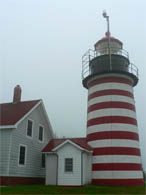
West Quoddy Head Lighthouse |
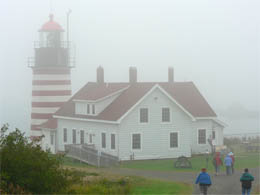
Cold, Wet and Foggy |
In 1808, West Quoddy Head Lighthouse became the easternmost lighthouse in the United States. (Why then did they call is "West" Quoddy? Because East Quoddy Head is just across the border, on Canada's Campobello Island.) West Quoddy’s light and a foghorn warned ships and boats of the dangerous cliffs and rocks, and guides them into the Lubec Channel between the U.S. and Canada. The lighthouse is critical because the most powerful tides in the world run up the channel. The tower is closed to the public, but still operated by the Coast Guard. We visited the small, but very cool museum. I especially liked the photos of a family who lived in the lighthouse from 1934 to 1952.
After visiting the lighthouse, we made our first excursion into Canada to see Campobello Island International Park. We stopped at the Visitor’s Center and two fun gals told us where to eat lunch – Sweet Things Bakery, housed in an old Victorian House. It was a folksy place serving the locals. I wondered about the locals after reading a handwritten sign on the wall that said, “No Bad Language.” Everyone around us looked pretty tame. We gobbled down some burgers and fries with chocolate cookies for desert.
After lunch, we visited the Roosevelt Cottage in the rain. This 34-room mansion-cottage is where Franklin D. Roosevelt spent summers on Campobello Island, in New Brunswick’s Bay of Fundy. The cottage and the grounds are preserved by the Roosevelt-Campobello International Park, jointly run by both the U.S. and Canada. The cottage today is like it was in 1920, but FDR visited the place from the 1880s to the 1930s. For a huge "cottage" it's surprisingly cozy and intimate.
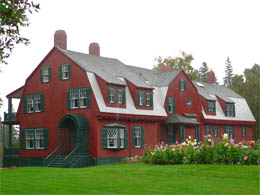
The Roosevelt Cottage |
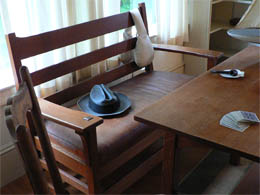
Roosevelt’s hat on a bench |
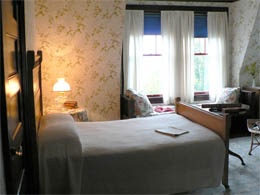
Roosevelt’s bed |
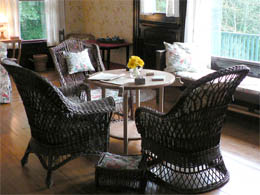
The family room |
The Roosevelt Cottage -- Background Information:
Like other affluent Americans, the Roosevelt family made an annual trek to Campobello Island. They summered at Campobello’s hotels and later built a cottage. FDR came to the island every summer between 1883, the year after he was born, and 1921, when he was stricken with polio. He spent summers exploring the coves, sailing, swimming, golfing, picnicking, horseback riding, bicycling, playing tennis, hiking and all the other activities available to a well-to-do Victorian family. Sailing was the most important part of the Campobello summer. He loved Campobello and called it his "beloved island."
Eleanor Roosevelt first came to Campobello in 1903 when she was nineteen. She and Franklin were courting and she came to visit the parents at James and Sara’s summer cottage.
The “cottage” next door to the parents’ summer place would become Eleanor and Franklin’s (and the place we visited). It was built in 1897 for Mrs. Hartman Kuhn, of Boston. Mrs. Kuhn adored Eleanor when she and Franklin summered at his mother’s cottage next door. When Mrs. Kuhn died, she offered her cottage to FDR’s mother, Sara, at a bargain price ($5,000.00). Eleanor furnished and ran the cottage on her own (without interference from FDR’s dominating mother).
From 1909 to 1921, Franklin, Eleanor, and their growing family spent summers in the cottage. They brought along a nurse and a governess to tutor the children, and several servants to run the cottage. The interior of the cottage was comfortable, but had neither electricity nor telephone. Kerosene lamps and candles were used throughout the house.
As a young father, FDR usually spent July, August, and part of September with his family. FDR and Eleanor’s third son was born on the island. FDR was an energetic and athletic father. He taught his children sailing. He organized hiking expeditions along the cliffs. Campobello was a part of the lives of his five children. In the cool evenings, FDR spent time working on his stamp collection; Eleanor knitted, wrote letters and read.
In the 1920 elections, FDR campaigned for the vice-presidency, but the Democratic ticket was defeated. Roosevelt then became vice-president of the New York office of the Fidelity and Deposit Company of Maryland. By August 1921, he was looking forward to a good rest at his beloved Campobello Island.
During this first extended summer at Campobello in more than a decade, he ran a high fever and his legs suddenly grew weak. At the age of 39, he had contracted polio. Eleanor and the five children continued to visit the island during the summers. However, because of FDR’s convalescence and involvement in politics, nearly twelve years passed before he came back to Campobello.
Franklin did not return to Campobello until 1933. After four years as Governor of New York (1929-1933), FDR was elected President. The first 100 days of his Administration were trying for him, and by June 1933, he needed a get-away to Campobello.
Eleanor returned to the island in 1935 to write a volume of her memoirs, later published as “This Is My Story,” the first volume of her autobiography. (During a summer visit in 1947, she worked on the second volume of her autobiography, “This I Remember.”)
Eleanor Roosevelt last came to Campobello in 1962, for the dedication of the FDR Memorial Bridge linking the island with Lubec, Maine. She died a few weeks after this last visit. |
FDR’s summer cottage in Campobello was done nicely. (The guides seemed bored and sleepy – maybe it’s the rainy weather.) I enjoyed learning about FDR and Eleanor and his meddling mother, Sara. It was like having a peek at their family scrapbook. (I’ll always remember the photos of handsome young FDR with his proud mama looking on and homely Eleanor usually in the background.) We were sorry it was raining and we couldn’t explore the 2,800-acre park with it’s scenic coastline and hiking trails.
We piled into the car, turned on the windshield wipers and told “The Bitch” where to go!
Even though it was raining, we stopped to see the Saint Croix Island International Historic Site in the Passamaquoddy Bay. We didn’t go on the island, but viewed it from a beautiful memorial sight with statues of the people who helped settle the land.
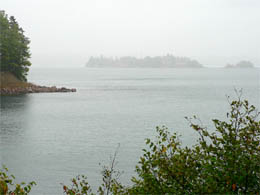
View of Saint Croix Island |
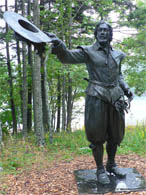
Pierre Dugua |
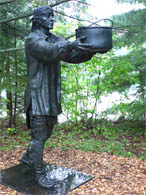
Native American offering help |
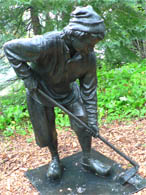
Colonist working the land |
A Little History - Saint Croix Island
In 1604, the French attempted to colonize Saint Croix Island, making it one of the earliest European settlements in North America. They called the territory l'Acadie. (By the way, the area around Saint Croix Island had already been inhabited for at least 4000 years before European settlement.)
In April 1604, Pierre Dugua led the two-ship expedition with blessings (and title and backing) from King Henri IV. Dugua’s job was to colonize North America and establish a lucrative fur trading post. Lots of beaver pelts were needed to supply the fur for men’s hats fashionable in European at the time.
The seventy-nine, all male, members of the expedition included carpenters, priests, farmers, soldiers and the famous Samuel Champlain. Champlain was a mapmaker, explorer and later called “Father of New France.” (By the way, Saint Croix Island was settled by Huguenots (French Protestants) and Catholics, a rare example of religious tolerance between these two groups.)
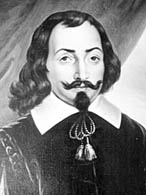
Samuel de Champlain
The severe winter of 1604-1605 was a cruel blow for the French expedition. Iced in by freezing temperatures and cut off from fresh water and game, 35 of 79 men died. Many died of scurvy, and were buried in a small cemetery on Saint Croix Island. The native people helped the group survive.
The supply ship from France, expected in the spring, was late, adding to the misery. When the ship finally arrived, Dugua hitched a ride back to France, never to return to the New World. In spring of 1605 the survivors, under the command of Samuel Champlain, left the island and founded the settlement of Port Royal, Nova Scotia. (We visited Port Royal later in our journeys and were further impressed by the multi-talented Champlain.) |
We drove only a short distance to Calais, the little border town. We filled up with gas (much cheaper on the U.S. side!). A young guy pumped the gas for us. That hasn’t happened in a long time. The line to cross the border was rather long. The kid who pumped our gas said that was typical for a Saturday. We went through customs and over a bridge to St. Stephen, New Brunswick. We drove right by the chocolate factory, anxious to get to St. Andrews, our final destination for the day.
About 5:00, we arrived at The Picket Fence, a 50’s style motel in St. Andrews. The inn keeper, Sue, was very friendly and her old black cat loved to curl up by the warm computer.
We unpacked and then drove into town, only a few blocks away. It was just starting to get dark. We walked about the lovely, wet, empty town – only a few souls milling around. We didn’t expect this on Saturday night in St. Andrews.
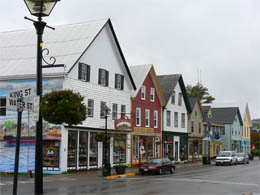
Corner of King and Water Streets - St. Andrews |
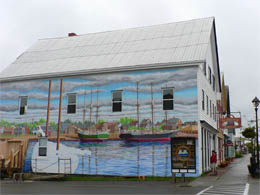
Art Everywhere! |
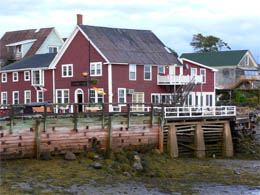
Town Pier – Tide is out, way out! |
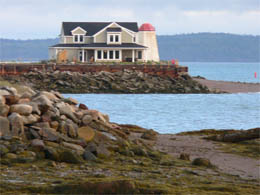
View from the Town Pier at Dusk |
We had a beer at the quaint Kennedy Inn Pub (218 Water Street) and found a little more action. A local artist / whaleboat guide sat next to us. He was enjoying a little happy hour before he had to pick up his 5-year-old son. It was nice chatting with him. He introduced us to the waiter who is an aspiring juggler. Oh the interesting folks you meet when you’re on the road.
We had dinner at The Gables (143 Water Street) – an informal eatery with wonderful views of the sea out back. Bill had fish chowder and a salad. I went for the fish and chips and ended up with a tummy ache afterwards. (Later discovered that the tummy ache was from carrying a money belt around my waist, not the food. You don’t need any stinking money belts in Canada – so off with my belt and off with my tummy ache!)
Came back to the room. Spent a couple hours in the office on the computer – The old black cat wasn’t happy about giving up his warm sleeping place.
9/16 - Sunday – St. Andrews, St. John, Alma (Fundy National Park) - New Brunswick
We checked out of the Picket Fence Motel and drove into St. Andrews for some blueberry pancakes at the Friends and Neighbors Café on Water Street – great spot for observing the locals. One guy, eating alone, was talking in a loud voice to the folks at the next table. He told them that he was at his Dad’s place when they saw a bear playing with the wheels on the wheelbarrow out back. His Dad picked up a rifle and went out and shot the bear. He laughed so loud when he said, “We’ll have plenty of meat for next winter.” Made me sick.
After breakfast we stopped at the Visitor’s Center to arm ourselves with more pamphlets. These places are great!
We first took a quick historical tour through town, visiting:
- The Blockhouse – built during War of 1812 to protect themselves from the aggressor Americans (hell bent on Manifest Destiny) just down south. However, no shot was ever fired from the blockhouse.
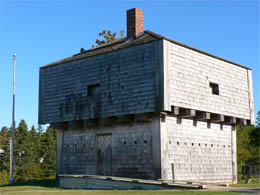
The Blockhouse |
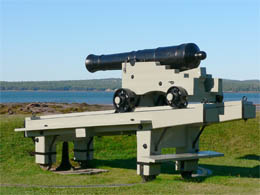
Canon outside the Blockhouse |
- The Algonquine Hotel – a tutor style grand hotel built in 1889, owned by the CPR – Canadian Pacific Railway. It burned to the ground in 1914 and was rebuilt immediately using only fireproof material.
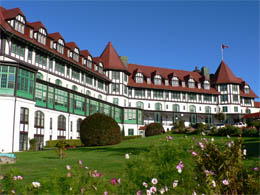
The Algonquine Hotel |
- A plaque along the rugged coastline that commemorated Irish immigrants who were quarantined to an isolated island as soon as they reached the shores. If they survived the quarantine, they could join the community – tough welcoming.
We were fascinated by the many churches in the town, built in the 1800’s only within a block of each other. They were still active today. We watched several people find their way to their own denomination.
- Greenock Church, built in 1824 with funding from Captain Christopher Scot of Greenock, Scotland. I liked the Greenock tree placed proudly on the steeple.
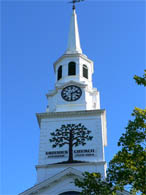
Greenock Church |
- The Baptist Church, built sometime in the 1860’s, was a “carpenter gothic.”
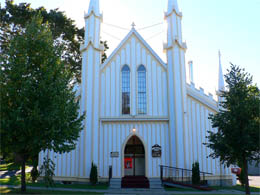
Baptist Church |
- St. Andrews’ Catholic church, built in 1886, was the busiest on the Sunday we were there.
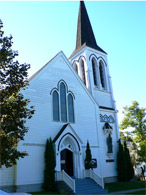
Catholic Church |
- All Saints Anglican, built in 1867, wasn’t too busy. We went in to look for the coat of arms of William and Mary, carved in wood and brought by some Loyalists from Connecticut seeking refuge in New Brunswick. (It was too dark to find the carving, so we went on.)
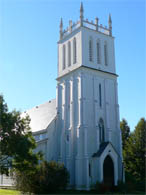
All Saints Anglican |
After we toured charming St. Andrews, we drove just a short distance to Chamcook and then over a sandbar (at low tide) and on to Minister’s Island Historic Site in Passamaquoddy Bay. The island is linked to the mainland by a sandbar and you can only visit the island for a couple of hours at low tide (entrance fee $12). We drove across the sandbar dodging sea gulls. At first, I thought the sea gulls were white flags to mark the road, but as we got closer, I discovered they were sea gulls – Oops!
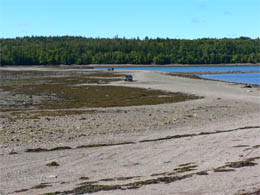
Driving over the sandbar at low tide |
Minister’s Island is over 500 acres and named for Samuel Andrews, the minister who first settled there in 1786. He was a loyalist Anglican minister and raised 12 kids in a charming stone house that is still standing. His son later became the prominent sheriff in town.
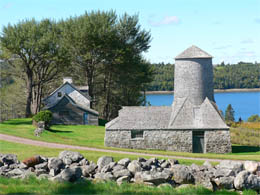
Minister’s Island |
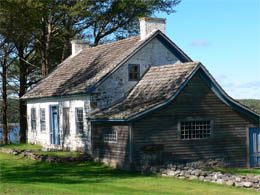
Parson Samuel Andrews’ house, 1786 |
A hundred years later (1891, to be precise), Sir William Van Horne bought the southern part of Minister’s Island and built a summer getaway (excuse me, I mean " estate"). Van Horne was Dutch and a self-made man. He immigrated with his family to Illinois. Later he went to work for the Canadian Pacific Railroad (CPR) where he was an engineer and inventor. Because of his cleverness and hard work, he became the President of the CPR and led the company in building the railway from the Pacific coast to the Atlantic. Many thought that connecting the railroad over such terrain was an impossible feat, but it only took him 4 and half years to complete the task.
Van Horne named his grand summer getaway Covenhoven after his father. It was a huge home with walls constructed from sandstone cut from the shore.
We joined our guide at Van Horne estate. She looked like our congresswoman Susan Davis and was very knowledge and very friendly, verging on hyper. She led us through the home, telling us all sorts of wonderful stories. We appreciated her enthusiasm. The old estate was in need of repair. The family “cottage” was sold and became a hunting lodge. Just recently, several local citizens formed a group to purchase and restore this wonderful piece of their heritage.
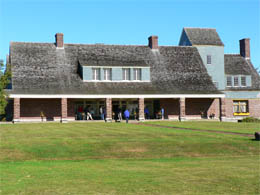
Covenhoven – Front yard |
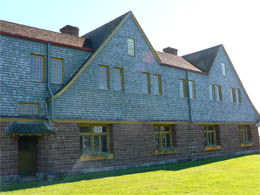
Side of the house |
Sir William Van Horne (he was knighted) married Lucille. They had two children – Benny and Adelaide. Adelaide was big and ugly and never married. Our guide said she was huge because she either had the disease elephantidis, or she inherited the large, stocky, Dutch physique. Adelaide was serious, worked hard and had a head for business. She died in 1941.
Van Horne’s son, Benny was a no good playboy who died at 39. He had Billy, the spoiled grandson and a granddaughter. Van Horne painted murals of Dutch nursery rhythms on the walls. One painting of a Teddy Bear that hung on the nursery walls, “Painted at the command of small William by his loving Grandfather.” Anyone could see that Billy had his powerful, tycoon Grandfather wrapped around his finger.
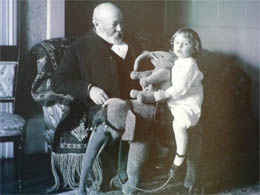
Van Horne and Billy, the Spoiled Grandson |
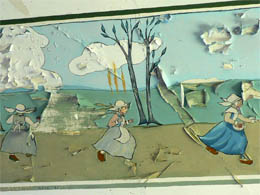
Dutch Nursery Mural painted by Van Horne |
Sir William spent hours drawing and painting. He became a well know artist. Some of his works were on display. He liked to hide his signature, or initials, within the paintings. He was a real jokester and played tricks on people. He also liked to play poker and go for swims.
The house had over fifty rooms, seventeen of which were bedrooms, and a grand drawing room. Of course, there were servants' quarters and a huge dining room as well as a billiard room where his ornate six by twelve table still stands today.
Also on the grounds were heated green houses (where mushrooms, exotic plants, peach trees and grape vines were grown), carriage house, huge state-of-the-art barn, creamery, gardens, carriage roads, bathhouse and windmills. In fact, the windmill, by the big house, with the help of kerosene-fired engines, provided running water to the house from a huge underground storage tank. On a remote island at the turn of the century the Van Hornes had many of the conveniences we have today and were almost self-sufficient.
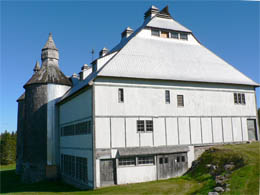
The Barn |
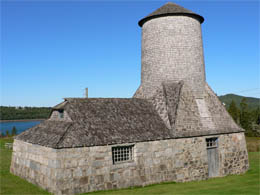
The Creamery |
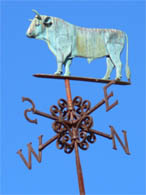
Wind Van on top of the barn |
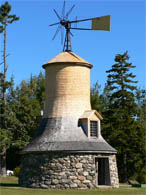
The Windmill |
When Von Horne was off the island staying at his Montreal home, he had the island’s fresh milk, butter, fruits and vegetables delivered overnight to him by rail from the end of the sand bar to Montreal.
After the house, we visited the amazing, gigantic livestock barn. It was the home for Von Horne’s thoroughbred horses and prized herd of Dutch belted cattle. The farm hands wore white-coats and maintained high standards for the care of the animals. Adelaide, the rather large daughter, loved the farming operations and won many prize ribbons for her animals.
We walked to the parking lot and left the island at 11:30 before the 12-noon high tide was due.
We drove down the road to the Atlantic Salmon Interpretive Centre (24 Chamcook Road – 4 miles from St. Andrews / Admission $4.) It was a beautiful, new center with outdoor pathways along the Chamcook Stream.
Our guide knew (and loved) everything about salmon. Atlantic salmon are different from Pacific salmon. They don’t die after they spawn. They grow new organs that will accommodate the change from fresh water to salt water. The rings on the scales, like rings on a tree, show how many seasons the salmon has survived.
Our guide was filled with facts. She said the first person to invent “fly” fishing was a nun living in Scotland in 1496. The nun’s job was to catch fish for the Catholics. She had to catch a lot of fish especially on Fridays. She discovered that Salmon snap at things annoying to them so she made objects that seemed to annoy the salmon and attached these objects to a wire – voila, we have fly fishing.
Our guide showed us the “Hall of Fame” of fly fisher people and demonstrated how the native animals caught salmon by spearing them. She was also poetic and told us that Hemingway said, “You don’t catch salmon, you fight with them.” Salmon come zooming out of the water at speeds of 30 mph and you have to do battle to reel them in.
We were having a grand old time absorbing all the guides’ fascinating facts when a French couple joined us. She then switched to her French 101 and bored us all. Then a family joined us and she switched to “kid talk” and bored us further.
She took us to a huge tank to feed the salmon. She introduced us to all 7 or 8 salmon – “This one is ten years old. This one has cataracts. We have to watch this one, etc.” It was as if each salmon was her personal pet. She told us of her disdain for seals – “They’re like rats that live in the water. Everybody gets teary eyed when they see people clubbing the baby seals on the ice. Don’t ever forget that they are nothing but RATS.”
I shouldn’t have said that farm-raised salmon eat their own poop because she went into a tirade. Eyes darting about, she said, “We have no choice but to farm salmon. Industry killed all the salmon in the wild. We’re Canadians. We don’t have armies to make things right. We don’t invade countries.” At that, Bill and I thought it was time to go. Hope she finds the right medication.
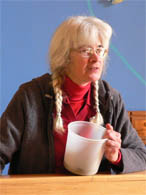
The Salmon Lady |
Time for lunch – looking for a place was a problem because most of the local joints were either closed for the season or closed on Sunday afternoons. Out of necessity, we stopped at a Subway Sandwich shop for a quick lunch. (Canada is loaded with Subways.) We split a big sub and were quite pleased.
“The Bitch” guided us to St. John’s to visit the New Brunswick Museum. Excellent – admission $6. The museum was located in the heart of town at Market Square within a 3-story mall. The statues at the entrance were whimsical and fun.
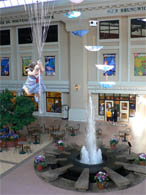
Museum housed within a 3-story mall |
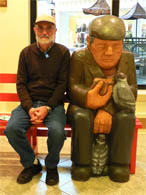
Bill sits with his statue friend |
The 3-story “Tidal Tower” sculpture on the first floor lobby extended to the third floor in an open stairwell. Through the two Plexiglas panels, the actual tide (from the Bay of Fundy outside the museum) rises and falls within the sculpture. Simple, amazing display dramatizing the vast changes in tide levels in this part of the world.
On the first floor, there were incredible displays of St. John’s history, displayed in recreated shops (lumber mills, ship building factories, etc). The shipping, lumber and ship building industries made St. John a very wealthy city. From the 1700’s to the 1900’s, there was always a huge demand for lumber and for ships. The British purchased war ships built in St. John to do battle with colonists during the American Revolution. The War of 1812 created another demand for war ships. Also, when Napoleon cut off access to the forests, the British turned to St. John for lumber and ships. Business here was good!
The second floor took you on a geological trail through time. It was a simple, brilliant display of the different time periods, each with a layout of the world, minerals (rocks), vegetation, sea and animal life starting at the beginning of time and ending with the Wooly Mammoth.
On the second floor, we were amazed to see a huge “Right Whale” skeleton hanging from the ceiling and then touch the actual baleen from this skeleton. A guide at the museum told us that this was the remains of Delilah killed by a ship’s propeller in the Bay of Fundy in 1992. Her baby calf, Calvin, swam away and survived. We first learned about Delilah from a lecture given in Bar Harbor by Scott Kraus (author of “The Urban Whale). It was exciting to see the size of the body and to touch her baleen. The guide also showed us the crustaceans (copopods), the tiny marine life that supply the food for these huge animals.
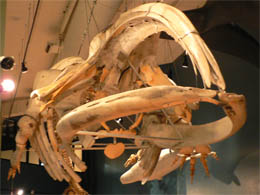
The remains of Delilah, the “Right Whale” |
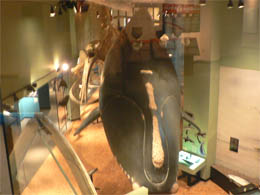
A “Right Whale” model |
The third floor housed furniture, china, pottery, fine art and decorative art. I was fascinated by the portraits of the early settlers, but what intrigued me most was a portrait of the British General James Wolfe who conquered the French for control of Quebec. However, he was killed in the battle in 1751. The artist captured him with eyes rolled up and head propped up to the side for this official portrait.
We were brain dead by the time we finished the third floor of the fabulous museum. Our day was packed with fun-filled facts. We got into the car, gave “The Bitch” our destination in Alma and took off. When we got tired of her barking directions at us, we’d turn her volume down. When we got mad at her, we’d just say, “Shut up, Bitch” and then giggle.
We drove through Fundy National Park and on into Alma, a small town just outside of the park. We parked the car and checked out 3 possibilities for lodging that night. We both liked The Captain’s Inn B&B -- $95 a night. It’s a very homey, cozy place. The Innkeeper and a couple of her girlfriends were sitting and knitting together in the enclosed front porch. They didn’t say much; just seemed happy to be together creating with busy fingers.
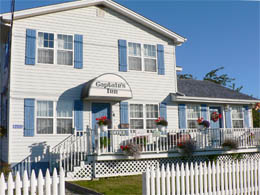
Captain’s Inn – Home Away from Home |
On the recommendation of the Innkeeper, we went next door to Harbor View Market and Restaurant. (The 7-11 type market has a little room tacked on the side for the restaurant.) The restaurant owner was huge and so were her servings. We split a fish dish with a baked potato and salad. Our tummies were stuffed as we waddled out the door. We learned that we missed a big event in town that Sunday afternoon at the State Fair – the goal was to see how many people could stuff themselves into a latex balloon. Now that would have been something to behold.
On our way back to The Captain’s Inn, we stopped to view the coast. The tide was out, way out, leaving the boats lying on their sides, amazing site. So much to see to fill our eyes and brains.
9/17 - Monday –Alma (Fundy National Park) - New Brunswick – Hiked 11 miles today
Had our basic scrambled eggs, bacon, toast breakfast at The Captain’s Inn B&B. Friendly group –John and Mary Ann from Iowa joined us. They were headed to Bar Harbor and coming from where we want to go so we exchanged travel advice.
We picked up a turkey sandwich at the place we had dinner the night before so we’d have our picnic lunch for our full day of hiking. We stopped at the Fundy National Park Visitor’s Center. A darling Rangerette helped us pick out some hikes and then sold us Canada Park and Historical Passes ($153 for 2). (We used the Pass throughout Canada and it proved to be a great savings.)
Fundy is gorgeous – manicured gardens, areas of mowed lawn, a golf course plus lots of forested area. The park is perched on the rugged coastline with wild fluctuating tides.
1st Hike – Third Vault Falls (4.5 miles)
We were cautioned by the young Rangerette that this hike might be too tough for us – but she didn’t know who she was talking to. We loved the cascading falls, rushing streams and steep, steep steps.

Nancy on the trail |

Steps straight down |

Moss covered rocks |

Third Vault Falls |
2nd Hike – Caribou Plain (1.5 miles)
The last caribou was seen here in 1907. Both caribou and moose were wiped out in this area and both were re-introduced years later, but only the moose took hold. However, today (and all the days to follow), we never did see a moose.
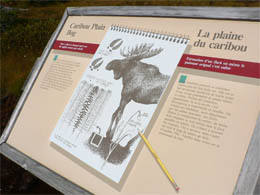
Trail Sign |
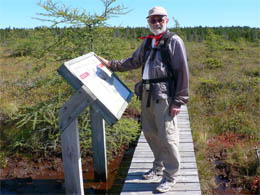
Bill on the trail |
Although this was a short hike, we loved it. It was mostly on a swishy boardwalk built over a bog. The bog has been around for 8,000 years. We saw some red pitcher plants and learned about sphagnum moss. Sphagnum moss serves as a sponge to soak up the water in the bog. We saw several “bonsai” spruce trees that have learned to survive in the bog’s tough environment. They can’t grow to normal height and some only produce seeds every 150 years.
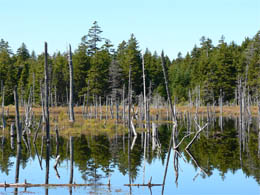
The Bog |
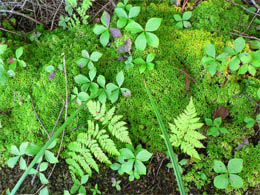
Sphagnum moss mixed with ferns |
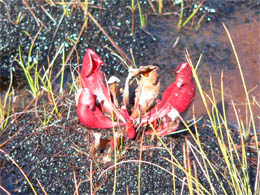
Red pitcher plant grows in the bog |
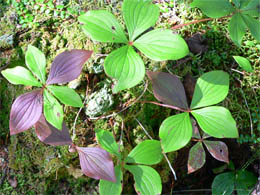
There’s beauty in the bog |
After our hike in the bog, we shared our turkey sandwich. It was delicious – made with real turkey breast, not that watery pressed together stuff. I only wished we had order two sandwiches!
3rd Hike – Dickson Falls (1.8 miles)
After lunch, we did another boardwalk hike through a valley past tumbling cascades to a magnificent waterfall. After we got off the boardwalk, the trails were covered with thick, protruding roots and lined with moss, ferns, and red-berried plants. Perfect Day.
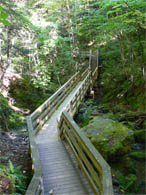
Trail to Dickson Falls |
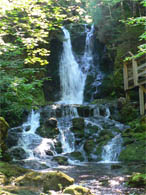
Dickson Falls |
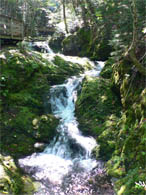
Surrounded by rushing water |
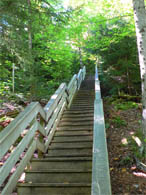
Trail up from the falls |
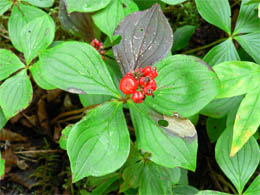
Red-berry plants |
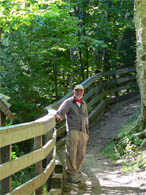
Bill on the trail |
We learned that acid fog is ten times worse than acid rain (which comes from auto emissions and industry). The fog in this seemingly environmentally clean place is killing the plants and birds.
4th Hike – Pt. Wolfe
We drove under a red covered bridge and then hiked to Pt. Wolfe overlooking the Atlantic.
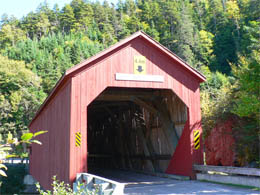
Covered Bridge |
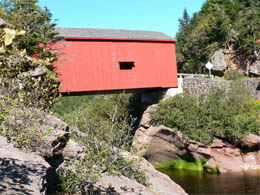
Covered Bridge from the side |
The self-guided trail follows a boardwalk. A telescope perched on an overlook was there for us to check out the spectacular views of the Point Wolfe River estuary and to look for birds. The interpretative signs documented the attempts to re-introduce Peregrine falcons to the area. We didn’t spot any falcons – maybe they had moved on.
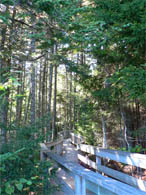
Boardwalk trail through forests |
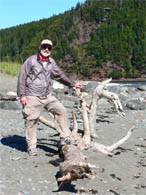
Bill with some drift wood |

View from the beach |

Pt. Wolfe estuary, once loaded with logs |
At Pt. Wolfe we saw evidence of the great lumber business in the 1860’s. Rotting logs, once a foundation of a building, were now strewn down by the water’s edge. The Spruce trees that covered the area were the perfect timber for boat masts. In their struggle between lumber and salmon, lumber won and salmon lost big time. Saw dust polluted the water and clogged the salmon’s gills, suffocating them. It didn’t take long to wipe out the huge population of salmon that once lived here.
5th Hike – Matthew’s Head (5 miles)
We hiked down an old forested wagon road to grassy meadows loaded with wildflowers – tiny daises, goldenrods, and all sorts of white and purple flowers. We also passed through wild raspberries.
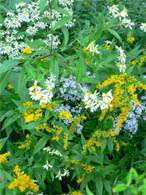
Splendid wildflowers |
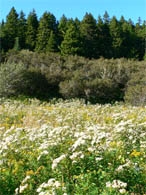
Meadows of wildflowers |
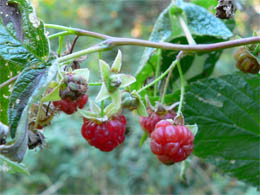
Wild raspberries |
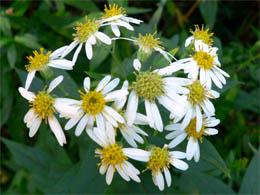
Amazing flowers |
The Matthews homesteaded this area back in the 1860’s. I could just imagine Ellen Matthews gathering berries around here. I thought I’d see some old foundation or evidence of their home, but no such luck. The hike dragged on and on through heavily forested and steep up-hills before we got to the cliff and one little panoramic view of the Bay of Fundy (which was named Matthew’s Head). Then we had a long haul back to the car. I do vividly remember seeing the best display of wildflowers on the endless hike back. (I only whined a little.)
6th (and last) Hike – Herring Cove (.5 miles)
We had one little hike left in us -- down to Herring Cove Beach and the tidal cave. It was very peaceful. The tide was going way out. We only saw 3 black birds on the beach eating mercury-infested muscles.
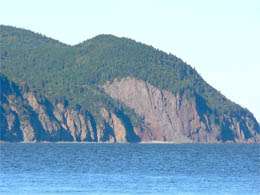
View from Herring Cove Beach |

Nancy at Herring Cove Beach |
We drove back to Alma, but were too late to check our emails at the Internet Café. We went back to The Harbor View Market Restaurant for dinner. I had a burger and wedgies (in spite of my heart condition). Bill was good and ordered seafood chowder.
Watched a little news from home – O.J. was arrested for armed robbery in Las Vegas. A plane crashed in Phucket, Thailand (we flew out of that airport a few years ago). Good news for us – beautiful weather in the forecast.
9/18 - Tuesday –Alma (Fundy National Park) - French River, Prince Edward Island (PEI)
What a gorgeous sunny day. Got to know a few more friends at breakfast – told them where to hike in Fundy National Park because we had covered most of the hikes yesterday.
We packed up and drove on down the road with Prince Edward Island as our goal. It was a breathtaking drive. The magnificent bright sunlight washed the simple barns and houses and created deep shadows against the gables and window frames. It was like viewing pastoral scenes in an art gallery – not a glitch on the canvas.
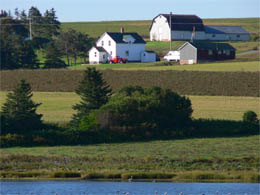
Farms and barns in the sunlight |
Just 20 minutes from Alma, we made our first stop at Cape Enrage, a lighthouse on the Bay of Fundy. Built in 1848, it is the oldest lighthouse in New Brunswick. Students refurbished it as a massive student project and the province purchased it in 2005.
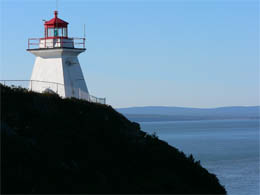
Cape Enrage |
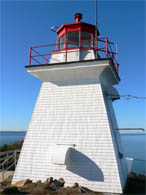
Cape Enrage |
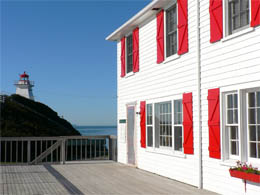
Lighthouse Keeper’s House |
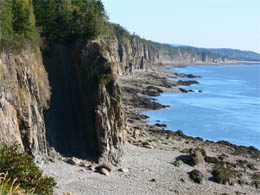
Coast next to Cape Enrage |
We distributed lots of chickadees nesting in the bushes around the lighthouse. We learned that the chickadee is Maine’s state bird.
We toured along the coast and were blown away by the beauty everywhere. We stopped at the “Ha Ha Cemetery” and then at The Sawhill Covered Bridge, 1869.
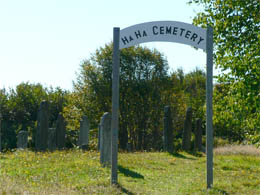
Ha Ha Cemetery |
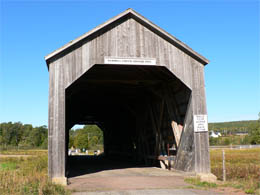
Sawhill Covered Bridge |
After a few more mini diversions, we decided to let “The Bitch” (the GPS voice) take control and lead us to the Confederation Bridge and then on over into Prince Edward Island. It’s a mistake to let “The Bitch” take control. She directed us to some roads that were closed in Moncton. Then she kept yelling at us, “Re-calculating!” Finally she took us to the northeastern scenic route, then, for no apparent reason, directed us back to the southeastern route. I disagreed with her decision, but Bill went along with her, that Bitch!
“The Bitch” finally got us to the Confederation Bridge – and what a sight it was. It spans 8 miles and connects Prince Edward Island (PEI) to New Brunswick. It opened in May of 1997 and is the longest bridge in the world to span ice-covered waters. It took four years to build and cost a billion dollars. The drive across the bridge seemed to go on and on. We thought we had to pass through a toll station on the PEI side to pay $10, but we were diverted to a PEI Visitor’s Center and outlet mall for souvenirs. We found a Subway sandwich shop at the mall to share a sandwich and then discovered a Cow Ice Cream shop to satisfy our sweet tooth. (Cow was voted best ice cream in Canada.)
After we gathered PEI travel information
from the Visitor’s Centers and filled our tummies, we were back on the road with “The Bitch.” She got us lost again – but that clever bitch somehow managed to skirt around the tollbooth and saved us the $10 toll. We kept saying, “Watch out, she’s going to take us back to the toll station!”
Our plan for the first night in PEI was to drive to Victoria on the south shore and spend the night. According to the tour books, Victoria is a charming little village that time forgot. The place was lovely, surrounded by sea on one side and potato fields on the other. However, the town occupied only four-square blocks – type “A” personalities could cover that place in 15 minutes. Since the day was young and we were antsy, we formulated Plan B – head to Summersville, a good gateway to lots of other activities. Summersville turned out to be too commercial – lined with motels and burger joints. We stopped at a mini mall of tacky shops built over the harbor. The place was sad – I did get Zi an Anne of Green Gables’ doll and a few other trinkets. The Visitor Center was next door so we made our stop for guidance. (These places are great! A friendly gal suggested that we check out some cottages in Cavendish, on the opposite side of PEI.)
We got to Cavendish and were disappointed in the cottages and all the miniature golf and water parks that were taking over the place, so we made another Visitor Center stop in Cavendish. What would we do without their help? A guy suggested a B&B (The Beach House Inn) in French River (20 minutes away). We headed down the road to French River and the most idyllic place we had seen on our trip – nothing but rolling farmlands, bales of hay, cows, perfect barns and farm houses all with magnificent views of the sea – not a blemish for miles.
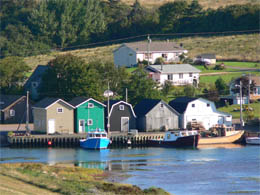
French River |
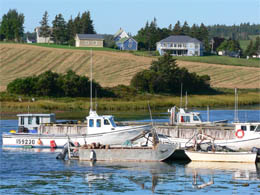
French River |
We arrived at The Beach House Inn B&B (Cape Road and River Road, off Highway 20). We were delighted. The place was a designer’s dream – everything tastefully done and a garage full of bikes.
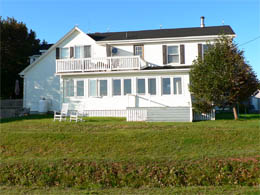
The Beach House Inn B&B |
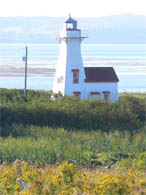
Just down the road from The Beach House Inn B&B |
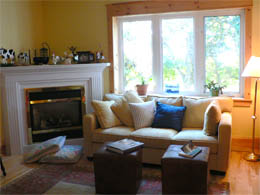
Cozy living room |
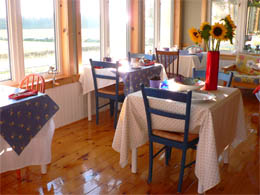
Breakfast room |
We quickly unpacked, grabbed our helmets and took the most delightful bike ride through this incredible place. (We learned that Lucy Maud Montgomery, author of Anne of Green Gables, called this place, “The Land of the Shining Lake.” What an inspiring place!)

Bill on the bike ride |
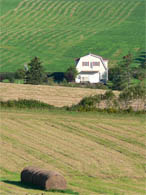
Beautiful scenery |
The bike ride was delightful. Only one dog tried to chase us down, but backed off easily. Even the Canadian dogs are nonviolent. I spotted what appeared to be a troubled teen, by a barn with his head hanging down with a dog close to him. At first I thought he was carrying a gun, but when we got closer, the wooden thing cradled in his arms turned out to be a fiddle. He was filling the quiet countryside with playful fiddle music. He was wearing a t-shirt that said, “I’m immature, unorganized, lazy and loud, BUT I’M FUN!” (His mom must have given it to him.) We asked him where to go to get a beer. He said that he didn’t know because he wasn’t old enough to drink, but he did point out a back way to our B&B, and off we went.

The Young Fiddler |

The Young Fiddler’s dog |
We road our bikes over hilly red mud roads with the ocean in the background. We passed low flying birds and a farmer baling hay in the last of the sun’s light. It can’t get any better than this . . .but it did. Our host at the B&B suggested we have dinner at The Home Place Inn and Restaurant in Kensington, the next town over. (The Home Place - 21 Victoria Street East – Kensington, PEI). Absolutely the best meal in Canada. We had baked haddock and almond crusted chicken and a salad with mixed leaves (not chopped!) with strawberry vinaigrette, topped off with a coconut cream pie. We are BAD (and happy)! We drove back to our lovely little room in French River to plan tomorrow’s adventure.
NOTE: Got an email that Chuck died today – We’ve know Chuck for years. Bigger than life guy – can’t believe he’s gone.
|











